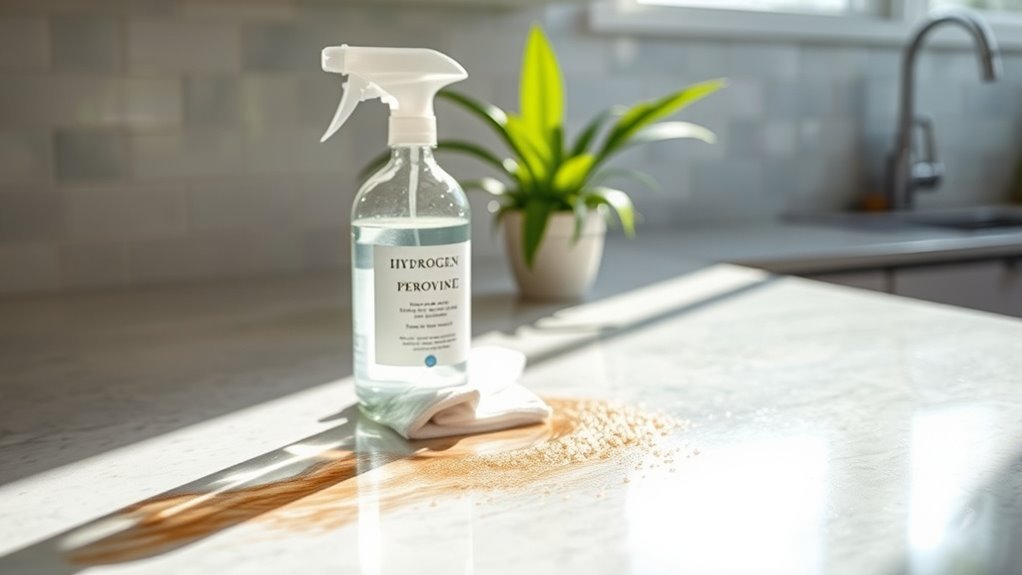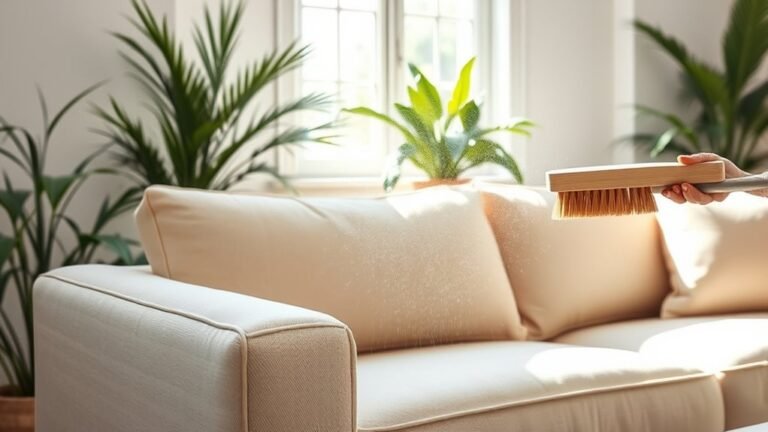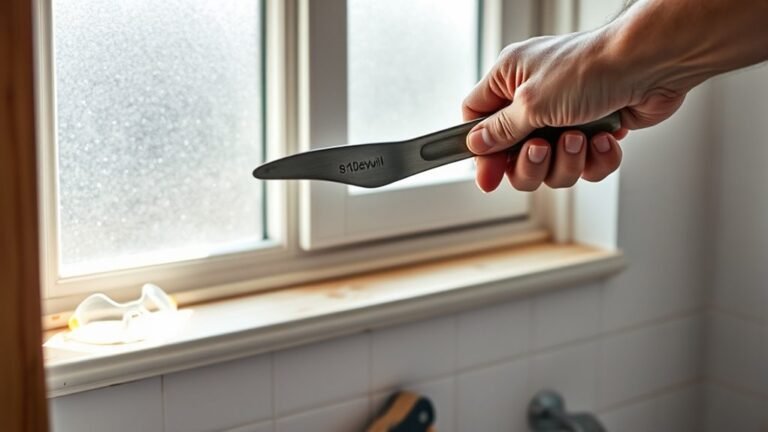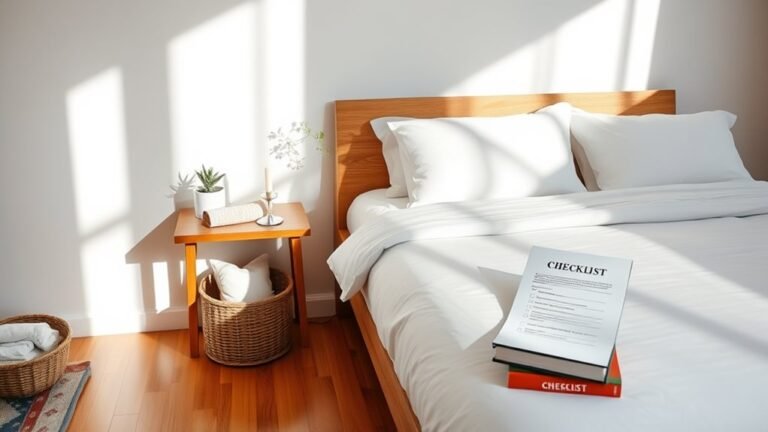Cleaning With Hydrogen Peroxide: Tips and Tricks
You can use 3% hydrogen peroxide as a safe, natural cleaner that disinfects surfaces, removes stains, and kills mold effectively. Just spray it onto countertops or fabric, let it sit for a few minutes, then wipe or rinse. Avoid mixing it with vinegar in closed containers and store it in a cool, dark place to keep it potent. With a few simple tips, you’ll enjoy fresh, sparkling results while protecting your home and health—there’s plenty more to discover.
How Hydrogen Peroxide Works as a Cleaner

Hydrogen peroxide works as a cleaner by releasing oxygen molecules when it comes into contact with surfaces. This release triggers hydrogen peroxide reactions that break down dirt, grime, and stains at a molecular level. When you apply it, the bubbling you see is oxygen being freed, lifting contaminants away without harsh chemicals. This natural process boosts cleaning efficiency, making it a powerful yet safe option for your home. You don’t have to rely on toxic cleaners to feel free in your space. Instead, harness the simple chemistry of hydrogen peroxide to keep your environment fresh and germ-free. It’s a smart choice that respects both your health and the planet, giving you the freedom to clean confidently and effectively.
Best Concentrations of Hydrogen Peroxide for Household Use
When you’re ready to use this powerful cleaner around your home, knowing the right concentration makes all the difference. For most household applications, a 3% hydrogen peroxide solution is your go-to. It’s strong enough to tackle stains, clean surfaces, and brighten laundry without causing damage. If you need something milder, especially for delicate fabrics or light cleaning, you can dilute it with water to lower concentration levels. On the other hand, stronger concentrations (above 6%) are usually reserved for specialized tasks and should be handled with caution. Sticking to the right concentration guarantees you harness hydrogen peroxide’s power safely and effectively, giving you the freedom to clean confidently without worrying about harm or residue. Understanding these levels lets you adapt this versatile cleaner for almost any household job.
Disinfecting Kitchen Surfaces With Hydrogen Peroxide

Although kitchen surfaces can quickly become a hotspot for bacteria and germs, you can easily disinfect them using a 3% hydrogen peroxide solution. Simply spray the solution on your kitchen countertop or cutting board, let it sit for a few minutes, then wipe clean. This method is free from harsh chemicals and effective.
| Surface | Application Tip | Dry Time |
|---|---|---|
| Kitchen countertop | Spray evenly, avoid puddles | 10 minutes |
| Cutting board | Apply, scrub gently if needed | 5 minutes |
| Sink area | Spray and let sit | 10 minutes |
| Handles/knobs | Spray and wipe thoroughly | 5 minutes |
This easy routine keeps your kitchen fresh and germ-free, giving you the freedom to cook with confidence.
Removing Mold and Mildew Using Hydrogen Peroxide
If you’ve noticed mold or mildew creeping in, hydrogen peroxide can be a powerful cleaner to tackle it. You’ll want to know the best ways to apply it for maximum effect while keeping safety in mind. Let’s explore how you can use hydrogen peroxide to remove mold without risking your health.
Effectiveness Against Mold
Since mold and mildew can quickly damage surfaces and affect indoor air quality, using hydrogen peroxide offers a powerful way to tackle these issues. It’s an effective surface treatment that not only removes mold but also aids in mold prevention by killing spores on contact. You get a cleaner, fresher space without relying on harsh chemicals that limit your freedom to live healthily.
Hydrogen peroxide bursts through mold’s defenses, breaking down its structure and stopping regrowth, so your surfaces stay protected longer. When you choose this method, you embrace a safe, natural solution that empowers you to reclaim your environment.
- Feel confident knowing your home is free from harmful mold
- Experience the freedom of a toxin-free cleaning routine
- Protect your space with a simple, effective mold prevention method
Application Methods
When you’re ready to tackle mold and mildew with hydrogen peroxide, knowing the right application methods makes all the difference. Start by choosing the appropriate application techniques—spraying is quick and effective for large areas, while using a cloth or sponge works well for targeted spots. Always test a small area first to verify surface compatibility, especially on delicate materials like wood or fabric. Apply hydrogen peroxide generously, letting it sit for 10-15 minutes to break down mold and mildew thoroughly. Afterward, scrub lightly if needed, then wipe clean with a damp cloth. These straightforward steps give you the freedom to clean confidently, guaranteeing your surfaces are refreshed without damage. Mastering these methods lets you maintain a mold-free space with ease and care.
Safety Precautions
Knowing how to apply hydrogen peroxide effectively sets the stage, but keeping safety in mind is just as important. You want to protect yourself and your space while enjoying the freedom of a clean home. Always wear personal protective gear like gloves and goggles to shield your skin and eyes from irritation. Make sure you’re working in a well-ventilated area to avoid breathing in fumes. And be prepared—know your emergency procedures in case of accidental contact or ingestion.
Remember these safety tips to keep your cleanup stress-free and safe:
- Wear personal protective gear to avoid harm
- Ventilate the area to breathe easy
- Keep emergency procedures handy for peace of mind
Stay safe, and reclaim your space confidently!
Whitening Grout and Tile With Hydrogen Peroxide
If your grout and tile have lost their brightness, hydrogen peroxide can be a simple and effective way to restore their original whiteness. For grout cleaning, mix hydrogen peroxide with baking soda to form a paste. Apply it directly to the grout lines and let it sit for 10-15 minutes. Then, scrub gently with a toothbrush or grout brush to lift stains and mildew without harsh chemicals. For tile whitening, you can spray hydrogen peroxide straight onto the tiles, especially in areas with discoloration or soap scum. Let it bubble and work for a few minutes before wiping clean with a damp cloth. This method frees you from stubborn grime, giving your space an instant fresh, bright look while keeping things natural and easy.
Stain Removal Tips for Fabrics and Carpets

Many stains on fabrics and carpets can be tackled effectively with hydrogen peroxide, making it a handy solution to have around. When you’re dealing with different fabric types or delicate carpet fibers, testing a small hidden area first is key to avoid damage. Remember, hydrogen peroxide works best on organic stains like wine, blood, or coffee.
Hydrogen peroxide is your go-to for organic stains—always test first to keep fabrics safe and fresh.
- Feel empowered as you revive your favorite clothes and rugs without harsh chemicals.
- Enjoy the freedom of a clean, fresh home with simple, effective tools.
- Celebrate the satisfaction of removing stubborn stains on your own terms.
Apply hydrogen peroxide directly to the stain, let it bubble for a few minutes, then blot gently. For carpets, use a soft brush to lift the stain, and always rinse with cold water to protect your fibers.
Safe Storage and Handling of Hydrogen Peroxide
When storing hydrogen peroxide, you’ll want to use a proper container that’s usually opaque and made of plastic or glass to keep it stable. Make certain to keep it out of direct sunlight, as exposure can cause it to break down quickly. Taking these steps helps maintain its effectiveness and guarantees safe handling.
Proper Container Selection
Choosing the right container for storing hydrogen peroxide is essential to maintain its effectiveness and guarantee safety. You want container types made from materials that won’t degrade or react with the peroxide. Typically, dark, sturdy plastic or glass containers are your best bet because they protect the solution and keep it stable. The storage materials must be non-reactive to avoid contamination or dangerous breakdowns.
When selecting a container, consider these key points:
- Feel empowered knowing your hydrogen peroxide stays potent and ready.
- Enjoy peace of mind with containers designed to prevent leaks and spills.
- Embrace freedom from worry by using materials that resist corrosion and damage.
Choosing wisely means you can use hydrogen peroxide confidently, without restrictions or hazards holding you back.
Avoiding Sunlight Exposure
Once you’ve picked the right container, the next step is to keep your hydrogen peroxide safe by protecting it from sunlight. Hydrogen peroxide is highly light sensitive, and sunlight exposure can break it down, making it less effective. To maintain its strength and guarantee it lasts, store it in a dark, cool place away from windows and direct light. You don’t want those UV rays sneaking in and degrading your solution. If you’re using it regularly, consider opaque or amber bottles that block out light. Remember, by preventing sunlight exposure, you’re preserving hydrogen peroxide’s cleaning power and extending its usable life. This small step lets you enjoy the freedom to clean effectively whenever you need, without worrying about your solution losing its punch.
Combining Hydrogen Peroxide With Other Natural Cleaners
Although hydrogen peroxide is a powerful cleaner on its own, combining it with other natural ingredients like vinegar, baking soda, or lemon juice can boost its effectiveness and tackle a wider range of stains and germs. These natural combinations create effective mixtures that empower you to clean more thoroughly without harsh chemicals. For example, mixing hydrogen peroxide with baking soda forms a fizzing paste that lifts tough grime, while combining it with lemon juice enhances whitening and freshness. Just remember never to mix hydrogen peroxide directly with vinegar in a closed container to avoid harmful gases.
- Feel the freedom of using safe, natural cleaners that protect your family and the planet.
- Enjoy the satisfaction of sparkling surfaces and fresh scents.
- Experience confidence in your cleaning routine’s power and simplicity.
Frequently Asked Questions
Can Hydrogen Peroxide Damage Wood Furniture?
You might wonder if hydrogen peroxide can damage wood furniture. While it’s great for disinfecting, it can sometimes lighten or dull the finish on wood surfaces. If you want to keep your wood care and furniture maintenance routine effective without risking damage, you should test it on a small, hidden spot first. That way, you enjoy freedom in cleaning without compromising your beautiful furniture’s look.
Is Hydrogen Peroxide Safe for Cleaning Electronics?
You’ll want to be cautious when using hydrogen peroxide on electronic devices. While it’s great for safe cleaning in many areas, it can damage sensitive components if it seeps inside. To protect your gadgets, avoid spraying directly; instead, apply it lightly on a cloth and wipe carefully. This way, you keep your devices clean without risking harm, giving you the freedom to maintain them safely and effectively.
How Long Does Hydrogen Peroxide Take to Disinfect Surfaces?
You might think hydrogen peroxide works instantly, but its disinfecting time usually ranges from 30 seconds to 10 minutes, depending on the surface and concentration. For surface effectiveness, letting it sit for at least one minute guarantees germs are properly killed. If you want freedom from harsh chemicals, this simple wait time can boost your cleaning power, giving you peace of mind without sacrificing safety or speed.
Can Hydrogen Peroxide Be Used to Clean Pet Stains?
Yes, you can use hydrogen peroxide for pet stain removal, and it’s pretty effective at breaking down the stain and odor. Just mix it with a bit of dish soap and baking soda for a stronger clean. You’ll want to test a small spot first to avoid any damage to your fabric or carpet. Using hydrogen peroxide lets you tackle stains yourself, giving you freedom from harsh chemicals and costly cleaners.
Does Hydrogen Peroxide Have an Expiration Date?
Yes, hydrogen peroxide does have an expiration date. Its shelf life is usually about six months to a year, depending on storage conditions. If you keep it in a cool, dark place and tightly sealed, you’ll help it stay effective longer. After expiration, it loses potency, so it won’t clean or disinfect as well. To enjoy its full power, just store it properly and check the date before using!






